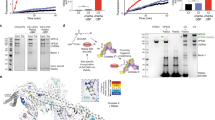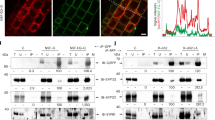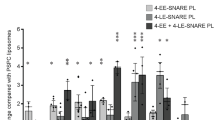Abstract
SNAREs (soluble N-ethylmaleimide-sensitive factor attachment protein receptors) and Rab-GTPases, together with their cofactors, mediate the attachment step in the membrane fusion of vesicles. But how bilayer mixing—the subsequent core process of fusion—is catalysed remains unclear. Ca2+/calmodulin controls this terminal process in many intracellular fusion events. Here we identify V0, the membrane-integral sector of the vacuolar H+-ATPase, as a target of calmodulin on yeast vacuoles. Between docking and bilayer fusion, V0 sectors from opposing membranes form complexes. V0 trans-complex formation occurs downstream from trans-SNARE pairing, and depends on both the Rab-GTPase Ypt7 and calmodulin. The maintenance of existing complexes and completion of fusion are independent of trans-SNARE pairs. Reconstituted proteolipids form sealed channels, which can expand to form aqueous pores in a Ca2+/calmodulin-dependent fashion. V0 trans-complexes may therefore form a continuous, proteolipid-lined channel at the fusion site. We propose that radial expansion of such a protein pore may be a mechanism for intracellular membrane fusion.
This is a preview of subscription content, access via your institution
Access options
Subscribe to this journal
Receive 51 print issues and online access
$199.00 per year
only $3.90 per issue
Buy this article
- Purchase on Springer Link
- Instant access to full article PDF
Prices may be subject to local taxes which are calculated during checkout






Similar content being viewed by others
References
Jahn, R. & Südhof, T. C. Membrane fusion and exocytosis. Annu. Rev. Biochem. 68, 863–911. (1999).
Pfeffer, S. R. Transport vesicle targeting: tethers before SNAREs. Nature Cell Biol. 1, 17–19 (1999)
Mayer, A. Membrane fusion: SNAREs only? Curr. Opin. Cell Biol. 11, 447–452 (1999).
Lindau, M. & Almers, W. Structure and function of fusion pores in exocytosis and ectoplasmic membrane fusion. Curr. Opin. Cell Biol. 7, 509–517 (1995).
Chernomordik, L. V. & Zimmerberg, J. Bending membranes to the task: structural intermediates in bilayer fusion. Curr. Opin. Struct. Biol. 5, 541–547 (1995).
Hanson, P. I. et al. Structure & conformational changes in NSF and its membrane receptor complexes visualized by quick-freeze/deep-etch electron microscopy. Cell 90, 523–535 (1997).
Skehel, J. J. & Wiley, D. C. Coiled coils in both intracellular vesicle and viral membrane fusion. Cell 95, 871–874 (1998).
Weber, T. et al. SNAREpins: Minimal machinery for membrane fusion. Cell 92, 759–772 (1998).
Otter-Nilsson, M. et al. Cytosolic ATPases, p97 and NSF, are sufficient to mediate rapid membrane fusion. EMBO J. 18, 2074–2083 (1999).
Brügger, B. et al. Putative fusogenic activity of NSF is restricted to a lipid mixture whose coalescence is also triggered by other factors. EMBO J. 19, 1272–1278 (2000).
Coorssen, J. R., Blank, P. S., Tahara, M. & Zimmerberg, J. Biochemical and functional studies of cortical vesicle fusion: The SNARE complex and Ca2+ sensitivity. J. Cell Biol. 143, 1845–1857 (1998).
Chen, Y. A. et al. SNARE complex formation is triggered by Ca2+ and drives membrane fusion. Cell 97, 165–174 (1999).
Xu, T. et al. Inhibition of SNARE complex assembly differentially affects kinetic components of exocytosis. Cell 99, 713–722 (1999).
Ungermann, C., Sato, K. & Wickner, W. Defining the functions of trans-SNARE pairs. Nature 396, 543–548 (1998).
Ungermann, C., Wickner, W. & Xu, Z. Y. Vacuole acidification is required for trans-SNARE pairing, LMA1 release, and homotypic fusion. Proc. Natl Acad. Sci. USA 96, 11194–11199 (1999).
Peters, C. & Mayer, A. Ca2+/calmodulin signals the completion of docking and triggers a late step of vacuole fusion. Nature 396, 575–580 (1998).
Peters, C. et al. Control of the terminal step of membrane fusion by protein phosphatase 1. Science 285, 1084–1087 (1999).
Pryor, P. R. et al. The role of intraorganellar Ca2+ in late endosome–lysosome heterotypic fusion and in the reformation of lysosomes from hybrid organelles. J. Cell Biol. 149, 1053–1062 (2000).
Colombo, M. I., Beron, W. & Stahl, P. D. Calmodulin regulates endosome fusion. J. Biol. Chem. 272, 7707–7712 (1997).
Holroyd, C., Kistner, U., Annaert, W. & Jahn, R. Fusion of endosomes involved in synaptic vesicle recycling. Mol. Biol. Cell 10, 3035–3044 (1999).
Porat, A. & Elazar, Z. Regulation of intra-Golgi membrane transport by calcium. J. Biol. Chem. 275, 29233–29237 (2000).
Mayer, A. & Wickner, W. Docking of yeast vacuoles is catalysed by the ras-like GTPase Ypt7p after symmetric priming by Sec18p (NSF). J. Cell Biol. 136, 307–317 (1997).
Ungermann, C., Nichols, B. J., Pelham, H. R. & Wickner, W. A vacuolar v-t-SNARE complex, the predominant form in vivo and on isolated vacuoles, is disassembled and activated for docking and fusion. J. Cell Biol. 140, 61–69 (1998).
Hartinger, J., Stenius, K., Högemann, D. & Jahn, R. 16-BAC/SDS-PAGE: a two-dimensional gel electrophoresis system suitable for the separation of integral membrane proteins. Anal. Biochem. 240, 126–133 (1996).
Cohen, A., Perzov, N., Nelson, H. & Nelson, N. A novel family of yeast chaperons involved in the distribution of V-ATPase and other membrane proteins. J. Biol. Chem. 274, 26885–26893 (1999).
Stevens, T. H. & Forgac, M. Structure, function and regulation of the vacuolar ATPase. Annu. Rev. Cell Dev. Biol. 13, 779–808 (1997).
Kane, P. M. & Parra, K. Assembly and regulation of the yeast vacuolar H+-ATPase. J. Exp. Biol. 203, 81–87 (2000).
Dunant, Y. & Israël, M. In vitro reconstitution of neurotransmitter release. Neurochem. Res. 23, 709–718 (1998).
Israël, M., Morel, N. & Lesbats, B. Evidence for an association of the 15-kDa proteolipid of mediatophore with a 14-kDa polypeptide. J. Neurochem. 57, 2047–2053 (1991).
Israël, M., Meunier, F. M., Morel, N. & Lesbats, B. Calcium-induced desensitization of acetylcholine release from synaptosomes or proteoliposomes equipped with mediatophore, a presynaptic membrane protein. J. Neurochem. 49, 975–982 (1987).
Mayer, A., Wickner, W. & Haas, A. Sec18p (NSF) driven release of Sec17p (alpha-SNAP) can precede docking and fusion of yeast vacuoles. Cell 85, 83–94 (1996).
Finbow, M. E. & Harrison, M. A. The vacuolar ATPase: a universal proton pump of eukaryotes. Biochem. J. 324, 697–712 (1997).
Weber, T. et al. SNAREpins are functionally resistant to disruption by NSF and alpha-SNAP. J. Cell Biol. 149, 1063–1072 (2000).
Umemoto, N., Yoshihisa, T., Hirata, R. & Anraku, Y. Roles of the Vma3 gene product, subunit c of the vacuolar membrane H+-ATPase on vacuolar acidification and protein transport. J. Biol. Chem. 265, 18447–18453 (1990).
Klionsky, D. J., Nelson, H. & Nelson, N. Compartment acidification is required for efficient sorting of proteins to the vacuole in Saccharomyces cerevisiae. J. Biol. Chem. 267, 3416–3422 (1992).
Morano, K. A. & Klionsky, D. J. Differential effects of compartment deacidification on the targeting of membrane and soluble proteins to the vacuole in yeast. J. Cell Sci. 107, 2813–2824 (1994).
Yamashiro, C. T. et al. Role of vacuolar acidification in protein sorting and zymogen activation: a genetic analysis of the yeast vacuolar proton translocating ATPase. Mol. Cell. Biol. 10, 3737–3749 (1990).
Kibble, V. A. & Burgoyne, R. D. Calmodulin increases the initial rate of exocytosis in adrenal chromaffin cells. Eur. J. Physiol. 431, 464–466 (1996).
Chen, Y., Duvvuri, V., Schulman, H. & Scheller, R. H. Calmodulin and protein kinase C increase Ca2+-stimulated secretion by modulating membrane-attached exocytic machinery. J. Biol. Chem. 274, 26469–26476 (1999).
Bennett, M. K., Calakos, N., Kreiner, T. & Scheller, R. H. Synaptic vesicle membrane proteins interact to form a multimeric complex. J. Cell Biol. 116, 761–775 (1992).
Galli, T., McPherson, P. S. & De Camilli, P. The V0 sector of the V-ATPase, synaptobrevin, and synaptophysin are associated on synaptic vesicles in a Triton X-100-resistant, freeze-thawing sensitive complex. J. Biol. Chem. 271, 2193–2198 (1996).
Harvey, W. R. & Wieczorek, H. Animal plasma membrane energization by chemiosmotic H+ V-ATPases. J. Exp. Biol. 200, 203–216 (1997).
Conchon, S., Cao, X., Barlowe, C. & Pelham, H. R. B. Got1p and Sft2p: membrane proteins involved in traffic to the Golgi complex. EMBO J. 18, 3934–3946 (1999).
Zimmerberg, J., Vogel, S. & Chernomordik, L. V. Mechanisms of membrane fusion. Annu. Rev. Biophys. Biomol. Struct. 22, 433–466 (1993).
Albillos, A. et al. The exocytotic event in chromaffin cells revealed by patch amperometry. Nature 389, 509–512 (1997).
Henkel, A. & Betz, W. J. Staurosporine blocks evoked release of FM1-43 but not acetylcholine from frog motor nerve terminals. J. Neurosci. 15, 8246–8258 (1995).
Scepek, S., Coorssen, J. R. & Lindau, M. Fusion pore expansion in horse eosinophils is modulated by Ca2+ and protein kinase C via distinct mechanisms. EMBO J. 17, 4340–4345 (1998).
Plattner, H. & Knoll, G. in Signal Transduction During Biomembrane Fusion (ed. D. H. O'Day) 19–46 (Academic, San Diego, 1993).
Garcia-Segura, L. M., Muller, D. & Dunant, Y. Increase in the number of presynaptic large intramembrane particles during synaptic transmission at the Torpedo nerve–electroplaque junction. Neuroscience 19, 63–78 (1986).
Chernomordik, L., Kozlov, M. M. & Zimmerberg, J. Lipids in biological membrane fusion. J. Membr. Biol. 146, 1–14 (1995).
Shevchenko, A. et al. Linking genome and proteome by mass spectrometry: large-scale identification of yeast proteins from two dimensional gels. Proc. Natl Acad. Sci. USA 93, 14440–14445 (1996).
Acknowledgements
We thank D. Gallwitz, P. Kane, R. Piper and M. Harrison for plasmids and strains; C. Baradoy for assistance; and the Boehringer Ingelheim Foundation and Deutsche Forschungsgemeinschaft (SFB446) for support.
Author information
Authors and Affiliations
Corresponding author
Rights and permissions
About this article
Cite this article
Peters, C., Bayer, M., Bühler, S. et al. Trans-complex formation by proteolipid channels in the terminal phase of membrane fusion. Nature 409, 581–588 (2001). https://doi.org/10.1038/35054500
Received:
Accepted:
Issue Date:
DOI: https://doi.org/10.1038/35054500
This article is cited by
-
A novel deletion mutation in the ATP6V0A2 gene in an Iranian patient affected by autosomal recessive cutis laxa
Irish Journal of Medical Science (1971 -) (2023)
-
The emerging roles of vacuolar-type ATPase-dependent Lysosomal acidification in neurodegenerative diseases
Translational Neurodegeneration (2020)
-
Expression profiling of genes coding for abundant proteins in the alkenone body of marine haptophyte alga Tisochrysis lutea
BMC Microbiology (2019)
-
Chromophore-Assisted Light Inactivation of the V-ATPase V0c Subunit Inhibits Neurotransmitter Release Downstream of Synaptic Vesicle Acidification
Molecular Neurobiology (2019)
-
Cooperative electrogenic proton transport pathways in the plasma membrane of the proton-secreting osteoclast
Pflügers Archiv - European Journal of Physiology (2018)
Comments
By submitting a comment you agree to abide by our Terms and Community Guidelines. If you find something abusive or that does not comply with our terms or guidelines please flag it as inappropriate.



